Rhizomes: Cultural Studies in Emerging Knowledge
Queer Bathroom Graffiti Matters: Agential Realism and Affective Temporalities
Andie Elizabeth Shabbar
 PDF
PDF
Abstract
This paper weaves together Deleuze's notion of the 'virtual/actual' and Barad's 'agential realism' in order to unravel how queer bathroom graffiti affects bodies in a particular space and time. I consider the materiality of bathroom graffiti and explore how queer inscriptions, architectural structures, manufactured materials, discursive practices, and human bodies are entangled phenomena with agential capacities. Drawing on the Baradian notion of 'intra-action', I argue that queer bathroom graffiti defaces conventional space-time configurations and, in so doing, transforms how gender and sexuality is experienced in public bathrooms.
Gender Politics in Public Bathrooms
Public bathrooms are a contested site of queer pleasure and queer pain. While restrooms are notoriously known as a space to cruise for gay sex, they are also a place of hostility where violence against trans, non-gender conforming folks, and queer sexuality occurs. Typically, North American public bathrooms are gender-segregated and designed in ways that allow the public to police and surveil gender and sexuality. Often trans people are denied entry, harassed, or assaulted while attempting to use the bathroom. As J. Jack Halberstam points out 'the bathroom problem' increases for gender ambiguous men and women, but even more so for trans people, who are often met with hostility and confrontation within this public space (28). Halberstam argues that while some genderqueers may be able to escape gender policing's watchful eye by passing as either male or female, others may have a harder time, especially if they identify outside of the gender binary (30). Therefore, genderqueers (who do not identify or comply with normative notions of either male or female) are forced to closet their gender (or non-gender) in public bathrooms and perform a subjectivity that is alien to their own. For this reason, restrooms are often avoided. As a consequence, the number of bladder-related health issues is disproportionally high within the trans and queer community (Herman 2013; West 67-68).
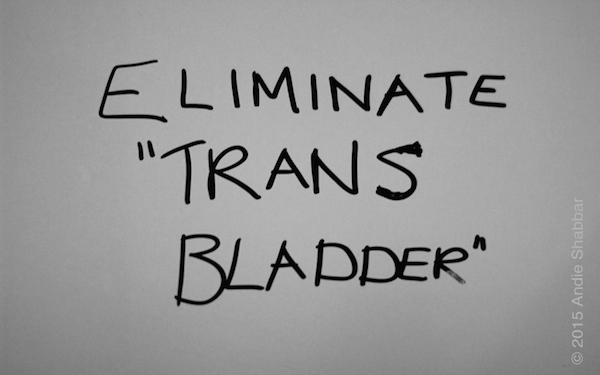
While trans rights activists have been fighting for gender-neutral lavatories since the 1970s (West 62), recently the 'bathroom bill' debates in Canada and the United States have garnered international news and social media attention. In Canada, Bill C-279, which would amend the Canadian Human Rights Act and Canadian Criminal Code to include gender identity as prohibited grounds for discrimination, has received a considerable amount of backlash from both policy makers and the public. One argument of those in opposition to the legislation is that the legal implementation of gender-neutral bathrooms would increase the occurrence of violence against women in public bathrooms. Not only is this argument rooted in the paternalistic and sexist notion that women are weak and need protection from men but it also perpetuates the transphobic view that 'woman' is a category only applicable to those who were assigned 'female' at birth. This cissexist definition of women erases from the conversation transwomen and the violence they experience in public bathrooms. More than just a concern for cisgender women's safety, the controversy over unisex bathrooms, Olga Gershehnson explains, "reveals cultural anxieties about the consequences of a slowly eroding gender binary" (206). It is in the context of these heated debates, fueled by deep-seated transphobic, sexist and homophobic ideologies that place the health, wellbeing, and lives of trans and queer people at risk, that I take interest in exploring the affective potentials and agential possibilities of queer graffiti in public bathrooms.
Writing on graffiti and gangs in a previous issue of Rhizomes, Gabriel Soldatenko (2013), distinguishes between three types of graffiti: restroom graffiti, graffiti tagging, and street art. He posits that bathroom graffiti is the least political of the three and is best thought of as "[an] utter randomness of phone numbers, racist remarks, off-color jokes, and sexual proclamations, all clustered together without any rhyme or reason". He claims that the political value of bathroom graffiti is hard to discern and suggests that it only functions as an impulsive form of self-expression. Conversely, Soldatenko maintains that, "merely because graffiti does not contain an obvious political message ... does not mean it lacks political value". He continues, "On the contrary, graffiti demands that we 'shift our perception' so that we can recognize a political value in graffiti..".. However, he paradoxically, dismisses bathroom graffiti as a valid form of activism. Alternatively, I posit that bathroom graffiti is political in both content and form and, as such, should be taken seriously as a creative tool for social change.
A Diffractive Exploration
Rather than taking graffiti as a representational object, this paper approaches bathroom graffiti as agential material phenomena with the capacity to affect bodies in new and unpredicted ways. At the heart of this approach is the proposition that apart from the interactions between human bodies, non-human matter, such as graffiti inscriptions, have the agential capacity to produce political potentials. To support this claim, I turn to Karen Barad's notion of agential realism and Gilles Deleuze's understanding of affect. In doing so, this paper offers a diffractive reading. A diffractive methodology, as Barad explains, is the practice of reading works and their differences through one another to recognize and create new entanglements of meaning. Thus, it is important to note that although Deleuze and Barad differ in their conceptualization of affect bringing their work into dialogue adds a layer of intensity and meaning in understanding the relationship between affect, agency, and queer bathroom graffiti. Briefly, for Deleuze, affect is a felt experience of the virtual and actual that occurs in singular events, whereas affect for Barad is conceptualized as a material phenomenon constituted by multiple 'intra-actions' between various human and nonhuman material bodies.
Barad's notion of 'intra-action' signals "the mutual constitution of entangled agencies" and recognizes that distinct matter does not precede its interactions but, instead, emerges through 'intra-actions' with other non-distinct matter (Meeting 33). Whereas the usual notion of interaction assumes a meeting between independently existing entities, the notion of 'intra-action' emphasizes that entities materialize in intra-action (Meeting 77). Thus, matter is never a fixed or passive thing but, rather, "matter is a congealing of agency" ("Posthumanist Performativity" 822). Barad's posthumanist philosophy emphasizes that all phenomena, including discourse and felt experience, are always-already involved in material 'intra-actions'.
Therefore, where Deleuze falls short, Barad's approach to affect and matter provides feminist theory with a more nuanced and useful understanding of how affect circulates (in its intra-actions) in between and beside discursive power. When brought into conversation—or read diffractively – the differences and similarities between Barad's and Deleuze's philosophy produce new conceptual phenomena through their own set of theoretical 'intra-actions'. It is these phenomena I attend to here. This intervention, then, weaves together Deleuze's notion of the 'virtual/actual' and Barad's 'agential realism' in order to unravel how graffiti 'intra-actively' affects queer bodies in a particular space and time. Exploring the material matter of bathroom graffiti, I maintain that queer graffiti inscriptions, architectural structures, manufactured materials, discursive practices, and human bodies are entangled phenomena that, in their 'intra-actions', deface conventional space-time configurations and, in so doing, disrupt the notion of a bounded coherent subject.
Barad's 'onto-epistemological agential realism', which considers the entangled practices of knowing and being, makes a rich and complex contribution to feminist and queer theory by reconsidering notions of performativity, agency, and materiality. However, rather than discussing the promising philosophical underpinnings or problematic aspects of Barad's theoretical apparatus, my interest, here, is to put her agential realism to work as a methodological and conceptual tool. Thus, this paper takes an agential realist approach to investigate how the material, as well as the discursive, dimensions of queer bathroom graffiti act as a disruption to the congealing of heteronormative space. It is important to note, here, that heteronormative space is not a pre-existing static container; it is also performative through its intra-acting phenomena. Nonetheless, heteronormative space can be defined as such through a number of repetitive intra-actions that occur in and around the space, such as the persistent modes of surveillance enabled by architectural design and gender signposting discussed below.
Public Bathrooms: 'An Architecture of Exclusion'
Gender-segregated public bathrooms are regulatory spaces that govern social, psychic, and spatial relationships. In Queering Bathrooms: Gender, Sexuality, and the Hygienic Imagination, Sheila Cavanagh traces Western histories of public toilets back to the late eighteenth century. Cavanagh explains that the typical North American modern restroom is socially structured to condition heterosexist and cissexist ideas of the body and sexuality (4). At the same time, the architectural design of public bathrooms allows for easy surveillance of bodies, and therefore regulates heteronormative performances of gender and sexuality. For instance, prior to entering public bathrooms, people are met with gender signposts that signify segregated lavatories. These signs require that individuals conform and adhere to a binary structure that precludes identifying as anything other than male or female in this space.
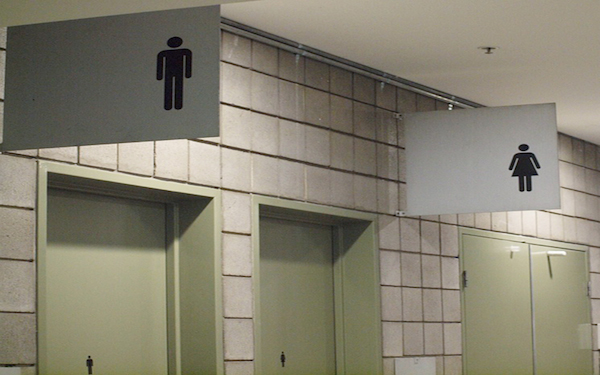
Surveillance of bodies continues past the outer signposts and inside the bathroom, through what Cavanagh terms 'an architecture of exclusion'. Cavanagh gives the urinal as an obvious example of how architecture reinforces cisgendered identification in its presupposition that all male-identified people stand to urinate. As a consequence, she posits, deviation from this given receptacle often raises suspicion (30). Beyond this, however, there are more insidious modes of closeting and un-closeting at work. Cavanagh describes how the height of toilets versus urinals, where the distance between genitals and receptacle differ according to gender (one must sit while the other stands), provides an acoustic means to discern and regulate gender differences (128-9). In addition, she contends, the many reflective surfaces (tiles, glass, glossy paint, and mirrors) as well as low-cut stall partitions and doors enhance the public's ability to code gender and sexuality (81).
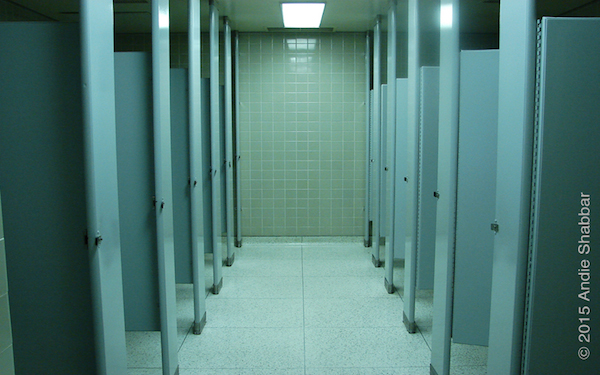
This panopticon-like environment is used not only to closet, and threaten to un-closet, non-normative genders but also gives the public a sense of entitlement to interrogate and police the presence of queer gender and sexuality. Conversely, queer graffiti, I argue, changes the bleak hygienic aesthetic of restrooms to a vibrant messy and communal atmosphere. And, at the same time the content of inscriptions directly challenges the hostility of transphobia and homophobia that is often felt in the space.
On the other hand, public bathrooms are also sites for queer pleasure. In their discussion of queer sex in public, Lauren Berlant and Michael Warner argue that the spectacle of public sex destabilizes heteronormative culture and in turn creates a 'queer counterpublic'. Sex in public, according to Berlant and Warner, challenges patriarchal ideologies that link sex with procreation, family, and heterosexual marriage by having sex out of place (198). What is more, same-gender sex in public, or simply having sex outside of the home, de-territorializes the boundaries between private and public space and calls into question the regulation of bodies. Similarly, queer bathroom graffiti messes up the heteronormative landscape by disrupting, resisting, and transforming the architecture of exclusion.
Like public sex, queer graffiti (literally) inscribes 'sexuality out of place' but, unlike public sex, it does so not through a sexual encounter between bodies in space and time, but through an encounter between bodies across spaces and times. In other words, the act of queer sex in public is a singular event, whereas queer bathroom graffiti is an ongoing phenomenon with multiple temporal intra-actions. Queer sex disrupts heteronormative flows in a certain space for a particular amount of time; bodies affect one another in their immediacy, intimacy, and presence. Differently, queer graffiti impinges upon bodies across time; graffiti inscribes sexuality out of place not through the physical proximity of bodies but through the distance between them. Bodies touch one another through written representations that traverse time.
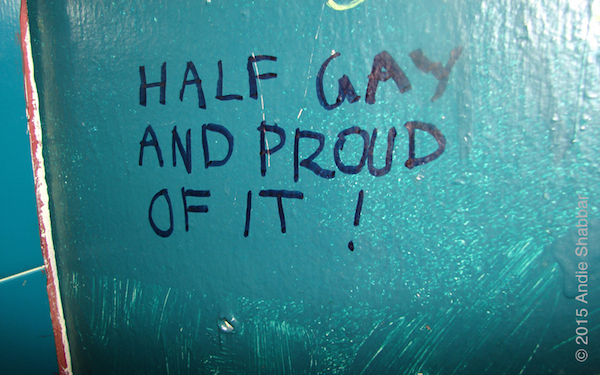
Queer Graffiti's 'Intra-actions'
Because bathroom graffiti, as a material trace of queer bodies, calls attention to the invisibility of non-normative sexuality in everyday space, it is often touted as a subversive form of self-representation that un-closets marginalized subjectivities and makes oppression visible (Carrington; Cole; Green). However, this representationalist perspective on graffiti assumes that a coherent sexual identity exists prior to its inscription. Queer graffiti has also been theorized as a 'coming-out' speech act (Davies and Knox). From this viewpoint, writing on the stall is not a representation of a pre-existing identity but, rather, the very act of writing queer graffiti does what it names: writing queer graffiti is not a representation but a production of queerness. That is, writing graffiti is performatively constitutive. From this perspective, queer graffiti is agentic because it transgresses normative notions of gender and sexuality by performing gender/sexuality outside of what is expected in the gender-segregated bathroom. However, the problem is that a performative, according to Judith Butler, "is [...] not the product of a choice, but the forcible citation of a norm" (232). Therefore, even though the act of writing queer graffiti may constitute non-normative sexuality, its performativity is always a reiterative and citational process of the very heteronormativity it seeks to subvert. Consequently, the very agency 'afforded by' queer graffiti is always already bounded by the discursive powers that govern it.
Barad's notion of agential realism, however, offers a way out of this paradox by providing feminist theory with a more dynamic and useful understanding of how agency operates. On an agential realist account, the agentic dimension of queer bathroom graffiti is not just that it allows queers to reclaim space or engage in constitutive speech-acts by discursively writing 'we're here and queer' on the stall's wall, but, also, through its intra-actions with human and nonhuman matter, queer graffiti has the potential to alter non-discursive material phenomena in its intra-actions with/in the world.
Barad puts forth a theory of 'posthumanist performativity' that accounts for the agentic qualities of matter; she explains:
A performative understanding of discursive practices challenges the representationalist belief in the power of words to represent preexisting things. Performativity, properly construed, is not an invitation to turn everything (including material bodies) into words; on the contrary, performativity is precisely a contestation of the excessive power granted to language to determine what is real. Hence in ironic contrast to the misconception that would equate performativity with a form of linguistic monism that takes language to be the study of reality, performativity is actually a contestation of the unexamined habits of the mind that grant language and other forms of representation more power in determining our ontologies than they deserve. ("Posthumanist Performativity" 802)
Barad's de-emphasis of language and attention to matter challenges Butler's theory of performativity that focuses on the discursive "regimes of regulatory production [that] contour the materiality of bodies" (Butler 17). Barad argues that Butler fails to explain how material matter produces bodies and, therefore, Butler's theory of performativity ends up reinscribing matter as a passive byproduct of discursive practices (Barad, "Posthumanist Performativity" 808). In contrast, Barad focuses on the interplay among many forms of materiality to underscore how experience and knowledge emerge out of multiple interactions between human bodies and the environments in which they are embedded. This understanding of material-discursive practices "cuts [agency] loose from its traditional human orbit" ("Posthumanist Performativity" 826). Namely, agency is not something humans have, it is not a product of human will, intentionality, or subjectivity—rather, matter is agentic because, as Barad states, matter is a continuous doing and a process of becoming. Matter, then, is not a fixed property of an object but the materiality of phenomena ("Posthumanist Performativity" 821). Barad's materialist position does not deny the importance of Butler's discursive analysis but insists that discursive practices and matter (human and nonhuman) entangle in a dance of agency performatively informing and merging into one another. Therefore, the dance of agency between nature and culture is one where agentic individuals do not exist prior to or independent of multiple interrelations, but, instead, emerge with/in and as them.
For Barad, matter is always open-ended, indeterminate, and different, thus making essentialist claims to anything impossible (Meeting 150; emphasis in original). In her words, agential realism understands that:
Discursive practices and material phenomena do not stand in relationship of externality to each other; rather, the material and discursive are mutually implicated in the dynamics of inter-activity. The relationship between the material and the discursive is one of mutual entailment. Neither discursive practices nor material phenomena are ontologically or epistemologically prior. Neither can be explained in terms of the other. Neither has privileged status in determining the other. Neither is articulated or articulable in the absence of the other; matter and meaning are mutually articulated. (Meeting 152;emphasis in original)
Thus, fixing graffiti as a nonhuman object and placing it in a dichotomous relationship with the graffiti writer as its governing subject excludes an entire field of possibilities in advance and forecloses important aspects of how queer bathroom graffiti matters. Envisioning, as Barad does, that bodies intertwine in expansive uncontained interactions between different agentic matter, I claim that the political importance of queer graffiti is not because it is self-representative or performatively constitutive, in the Butlerian sense, but, rather, because it engages in material-discursive processes. Like Barad, Dimitris Papadopoulos writes that Deleuze and Guattari warn, "when representations are considered separate from matter they become strategic tools for ordering and organizing material reality" (74). In this regard, queer graffiti as a representation only has agentic efficacy insofar as it is considered to be a performative formation of matter.
In all cases, the intra-action between discursive and material matter is what affects the being, knowing, but more importantly, the doing of bodies. Following Deleuze's assertion that "we can never know in advance what a body can do. We never know how we're organized and how the modes of existence are enveloped in somebody" ("Ontologie-Ethique" 3), the goal here is not to 'discover' exactly what queer bodies do to queer heteronormative space or what queer bathroom graffiti does to queer bodies, but to work within a Deleuzo-Baradian framework to consider how these phenomena intra-act as forces mutually affecting each other in unpredictable ways.
The Affective Capacity of Queer Bathroom Graffiti
Queer bathroom graffiti is an affective force, a bodily trace that has the potential to move matter from one state to another. Expanding on Spinoza's distinction between affection (affectio) and affect (affectus), Deleuze explains that 'affection' is the corporeal trace, the state of the affected body, and 'affect' is the movement from one state to another in the affected body. Affect, then, is the ability to affect and be affected; it "refers to the passage from one state to another, taking into account the correlative variation of affecting bodies" (Bergsonism 49). According to Brian Massumi, affect, unlike emotion, which is semantically and semiotically formed, can be explained as a visceral impingement on the body, an incomprehensible sensorial event that escapes intellection. Massumi explains the fundamental difference between affect and emotion: "emotion is qualified intensity, the conventional, consensual point of insertion of intensity into semantically and semiotically formed progressions" (221). Emotion is the idea given to cognitively express bodily sensation. Emotion attempts to actualize affect by putting it into words. Therefore, emotions are embedded within dominant discourses while affects escape habitual knowledge by following 'lines of flight' in unpredictable directions (Deleuze and Guattari 226-227). As forces of pure intensities, affects do not turn inward but always face outward thus escaping comprehensive captivity; "affects are projectiles just like weapons; feelings are introspective like tools" (Deleuze and Guattari 400). Nonetheless, affects are not actions that have been exerted but rather powers and forces to act. Returning to Barad momentarily, we could say that this conceptualization of affect is synonymous with her description on the performativity of matter since both notions attend to the indeterminacy of multiple potentials and intra-actions.
According to Deleuze (Pure Immanence), an affective event is a meeting of the virtual and actual, of incorporeal concepts with the materiality of the world. The virtual, in Deleuze's most basic definition, is duration that is real but not tangible, whereas, the actual is that which has been actualized from the virtual to form a spatial object. For example, memories exist in the virtual, and although they are not actual material objects they are thus nonetheless real. An artistic rendering of a memory is actual in that it actualizes the virtual (memory) by turning it into an object. Extending the complexity of this relationship further, Deleuze imagines the virtual as a topological figure, "a singular point in manifold" that continuously transforms from one shape to another, enfolding and folding without ever being cut or divided (DeLanda 15). Relatedly, Barad argues that intra-acting phenomena make 'agential cuts', including and excluding indeterminacies in order to make sense of the world. In her words, agential cuts are "ongoing topological dynamics of enfolding whereby the spacetimematter manifold is enfolded into itself" (Meeting 177). Thus, some things, certain forms of matter for example, are more visible and others impossible to see. In other words, meaning is always already predicated on the unintelligible as it is the case that all that is visible exists on a continuum with that which remains to be seen. Accordingly, Barad's cuts can only be understood as superficial and, at most, contingently temporary as everything is always deeply connected with everything else ("Posthumanist Performativity" 808).
By weaving Barad and Deleuze together, it becomes possible to think of 'agential cuts' as folds to the virtual. In their folding, agential cuts actualize a particular articulation within a given phenomenon. During an affective event, for example, an agential cut is made to actualize affect by capturing or comprehending it as emotion. However, according to Barad, agential cuts do not create an exterior or constitutive outside of phenomena, rather, "agential separability is a matter of exteriority within phenomena" (Meeting 177). Thus, the imperceptible virtual dimension of affect is the inter-exteriority of the affective phenomena. Hence, emotion and affect, for Barad, are intra-acting phenomena that emerge through and with one another. Whereas for Deleuze, affect exists prior to the comprehension of emotion, which is semantically and semiotically formed. It is tempting, then, to suggest that actualization is akin to 'agential cuts' and 'exteriority within phenomena' is similar to Deleuze's notion of the virtual. But on the contrary, the virtual and the actual, for Deleuze, never coincide within phenomena because they are mutually exclusive aspects of the real. In contrast, there are no mutually exclusive aspects of matter or real materiality for Barad.
Despite this disjuncture, the virtual, like 'intra-actions' between material-discursive matter, continuously changes or becomes other than what it is, but at the same time always remains immanent to what it once was. Unlike an actual object that never reveals more of itself in time, the virtual is a constant becoming. The virtual simultaneously contains the past and reaches into the future through the very potential of its own emergence. Virtual duration, Massumi writes, "is non-linear, moving in two directions at once: out from the actual (as the past) and into the actual (as the future)" (58). Extending Deleuze's understanding of the virtual and Barad's notion of agential realism to gender politics in public bathrooms, we can begin to unpack the affective temporality of queer graffiti's material-discursive intra-actions.
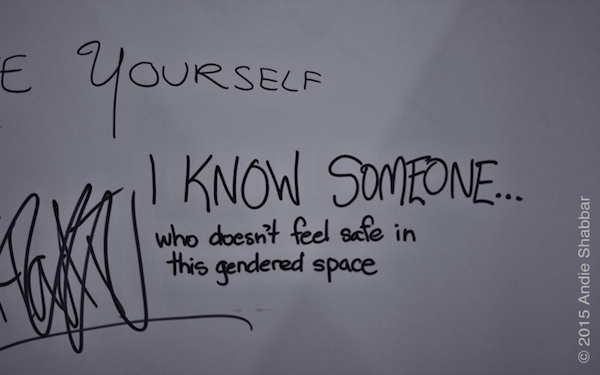
Queer Graffiti and Affective Temporalities
Queer graffiti's capacity to affect other matter is enhanced because it exists both in virtual duration and as an actual object. The virtual, in its duration, is continually new while it encompasses the past. Likewise, bathroom graffiti's temporality is nonlinear in that it has no marked beginning or end. Graffiti is written into the future for new bodies to encounter but its material composition remains uncertain. How will inscriptions change in future intra-actions with other bodies? Will someone else respond to the graffiti, add to it, scratch parts out, or erase it entirely? How will these alterations change the meaning of inscriptions and their potential (to) affect? These material indeterminacies, internal to the form of graffiti, destabilize an inscription's future and at the same time have the potential to alter the past an inscription seeks to signify or represent. In this way, bathroom graffiti's future becoming is always already a refiguring of its own past.
A multiplicity of queer inscriptions sprawled on the stall's walls recalls the multiplicity of queer bodies that wrote, and will write, graffiti and therefore moved, and will move, with/through/against the folding and enfolding of heteronormative space. Accordingly, queer bathroom graffiti not only recalls other queer bodies but also conjoins and infuses different bodies by touching them across time. In addition to its time travels through queer meetings before and beyond, bathroom graffiti may also exist literally beside bodies during a sexual encounter in public bathrooms, perhaps affecting the ways in which those bodies experience pleasure. In an encounter with queer bathroom graffiti, there is a morphogenesis of virtual and actual matter, expanding fields of potentiality, with any number of agential cuts, all transpiring beyond perceptible awareness. These divergent but simultaneous intra-active temporalities expand the field of graffiti's agentic capacity to affect.
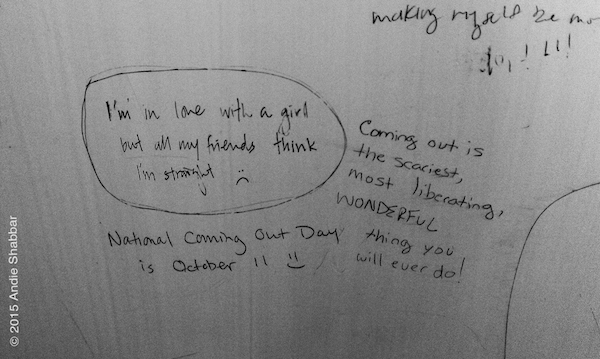
Queer bathroom graffiti is an affective assemblage. Deleuze and Guattari define assemblages as the gathering of any number of things or moments into a single context. As a flattening out of time, assemblages are absent of a continuous succession of moments that move from one privileged point to another (3-4). Alternatively, each moment is just as any other, mapped out without attributing value to one instance over another. What potentially follows out of a meeting of moments cannot be predetermined; it emerges at the possible site of connection. Queer bathroom graffiti is comprised of any number of things and moments including interactions between human bodies, textual discourse, heteronormative space, politics, material surfaces, ink, anti-bacteria solvents, and other unpredictable materials. Thus, as a coalescence of contingent human and nonhuman forces, the assemblage of queer bathroom graffiti has the potential to disorganize and reorganize patterns of thought, as well as the materiality of matter, by affecting one another through multiple diffractive processes. Numerous unexpected meetings occur at both the cellular and discursive level manifesting new phenomena and sensation. For instance, some cleaning products have a hard time removing graffiti; rather than erasing inscriptions completely, the chemical properties of the cleaner make new agential cuts, changing the color and/or opacity of graffiti, sometimes to the point where the inscription is barely traceable. These unpredictable intra-actions between the human, who wrote the graffiti or who will encounter it, and the non-human, such as the marker, chemical agent, and surface, move graffiti into new assemblages with new material affects.
Re-conceptualizing affect through a diffractive reading of Deleuze and Barad, as I have done here, highlights the dynamism of queer graffiti as not simply a relationship between object and subject but as a material-discursive phenomenon. Queer bathroom graffiti exists, to use Deleuze and Guattari's language, on a 'plane of immanence' where all dualisms and divisions flatten out, including interiority and exteriority, nature and culture, and discourse and matter. Thus, there are no real distinctions between subject and object—only networks of particles, forces, and affects that exist in "relations of movement and rest, speed and slowness between unformed elements, or at least between elements that are relatively unformed, molecules, and particles of all kinds... subjectless individuations, constituting collective assemblages" (Deleuze and Guattari 226).

An Indeterminate Conclusion
I have argued that queer bathroom graffiti produces affect through its 'intra-actions' between various human and non-human matter. Permeating porous surfaces and eliciting human sensation, queer bathroom graffiti transforms the bathroom's architecture of exclusion: a clean, sterilized, gender-oppressive anxious space to 'an architecture of inclusion': a queer, creative, indeterminate place full of possibilities. However contingently, queer graffiti becomes a part of the public bathroom's architectural aesthetic engaging the materiality of space and transforming the heteronormative organization of bodies. Although graffiti alone will not eliminate incidences of transphobia and homophobia in public restrooms, queer graffiti has the capacity to produce new subjective states through its affective and agential qualities. That is to say, the virtual temporality of queer graffiti intensifies the multiple becomings of queer bodies in their discursive and material formations. And in these modes of becoming, queer bodies always-already escape any fixed category of knowing or being and instead participate in an agentic realism of doing. For those reasons, queer graffiti has significant material affects on the political relationship between spatial matter, queer bodies, and the performative representation of queerness.
Aside from moving the debate on sexuality and public bathrooms into an unfamiliar philosophical direction, this intervention hopes to offer a virtual strategy, if you will, from which tangible forms of theoretical engagement and political action can begin to actualize. The odd pairing of queer graffiti and agential realism intends to de-territorialize feminist analyses and political actions on gender politics in public bathrooms that are conceptually bounded by representationalism and discursive analyses. The analysis I have offered here attempts to think outside of human subjectivity and consider the nonhuman forces of the world and the ways in which they matter. It understands that our discursive actions in the world are but one generative force acting alongside the material matter of the world. Barad's onto-epistemological materialist approach—that is, an approach that considers knowing and being by attending to the entanglement of matter and meaning—is only a starting point towards an uneasy and uncertain exploration of queer materiality. However, only by embracing the unknowingness of material phenomena can we begin to map the ways in which bathroom graffiti has the capacity to affect queer bodies and their future becomings in the world.
Works Cited
Barad, Karen. Meeting the Universe Halfway: Quantum Physics and the Entanglement of Matter and Meaning. Durham, N.C.: Duke University Press, 2007.
—. "Posthumanist Performativity: Toward an Understanding of How Matter Comes to Matter". Signs: Journal of Women and Society 28.3 (2003): 801-31.
Berlant, Lauren, and Michael Warner. "Sex in public". Critical Inquiry 24.2 (1998):547-66.
Butler, Judith. Bodies that Matter: On the Discursive Limits of "Sex". New York: Routledge, 1993.
Carrington, Victoria. "I Write Therefore I Am: Texts in the City". Visual Communication. 8.4 (2009): 409-425. Print.
Cavanagh, Shelia L. Queering Bathrooms: Gender, Sexuality and the Hygienic Imagination. Toronto: University of Toronto Press, 2010.
Cole, Caroline. "O wise women of the stalls...". Discourse & Society 2.4 (1991): 401-11.
Davies, Cristyn,and Elena Knox. "Disturbing the Dialectics of the Public Toilet with the Water Closet". Hecate 33.2 (2007): 120-34.
DeLanda, Manuel. Intensive Science and Virtual Philosophy. London: Continuum International, 2002.
Deleuze, Gilles. Bergsonism. Trans. H. Tomlinson, and B. Habbergjam. Brooklyn: Zone Books, 1988.
—. "Cours Vincennes: Ontologie-Ethique". 21 December 1980. Lecture. Web. 14 May 2012.
—. Pure Immanence: Essays on A Life. Trans. A. Boyman. New York: Zone Books, 2001.
—. and Felix Guattari. A Thousand Plateaus: Capitalism and Schizophrenia. Trans. B. Massumi. London: Continuum, 1987.
Green, James. "The Writings on the Stall. Journal of Language and Social Psychology 23.3 (2003): 282-296. Print.
Gershenson, Olga. "The Restroom Revolution: Unisex Toilets and Campus Politics". Toilet: Public Restrooms and the Politics of Sharing. New York and London: New York University Press, 2010. 191-207.
Halberstam, Jack J. Female Masculinity. Durham, N.C. and London: Duke University Press, 1998.
Herman, Jody L. "Gendered Restrooms and Minority Stress: The Public Regulation of Gender and its Impact on Transgender People's Lives". Journal of Public Management and Social Policy. 19.1 (2013): 65-80.
Massumi, Brian. Parables for the Virtual: Movement, Affect and Sensation. Durham, N.C. and London: Duke University Press, 2002.
Papadopoulos, Dimitris. "Activist Materialism". Deleuze Studies. 4 (2010): 64–83. Print.
Soldatenko, Gabriel. "The Politics of Writing on Walls". Rhizomes: Cultural Studies in Emerging Knowledge. 25 (2013): n. page.
West, Isaac. Transforming Citizenship: Transgender Articulations of the Law. New York and London: New York University Press, 2014.
Notes
- In response to the transphobic opposition by conservative governments and various religious groups, trans rights campaigns such as 'occupotty' and 'we just need to pee' have gone viral on social media. Using the campaign names as hashtags, users take 'selfies' in bathrooms to express their uncomfortability or to illustrate how their gender does not coincide with the particular signage or facilities offered in a gender-specific bathroom.
- The former Canadian government blocked the passing of Bill C-279 in summer 2015. However, it should be noted that the newly elected Canadian Prime Minister Justin Trudeau has stated that he fully supports trans rights and plans to reintroduce the Bill to Parliament as a government bill rather than a private member's bill (a private member's bill does not often become law).
- Despite a recent increase of gay and lesbian representation in media and popular culture, non-conforming genderqueers, particularly queers of colour, trans men, trans women of colour, and bisexuals remain largely marginalized and invisible in everyday space.
- Although I argue that affect is a productive force, affects do not always produce positive effects. Thus, homophobic bathroom graffiti, in fact any graffiti, can also produce affect with negative effects.
- For Barad's brief remark on the distinction between her understanding of the possible/real and Deleuze's notion of the virtual/actual, see Meeting the Universe Halfway (176, 438n80).
Cite this Article
https://doi.org/10.20415/rhiz/030.e06
